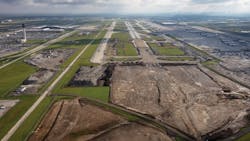How Indianapolis International Airport’s Runway Project Sets a New Standard for Sustainability
In a time when airport infrastructure projects are increasingly scrutinized for their environmental impact, Indianapolis International Airport (IND) has set a new benchmark in sustainability.
The $251.7 million Runway 5R-23L and Taxiway D Strengthening and Capacity Enhancement project not only addressed critical infrastructure needs but also integrated innovative sustainability solutions that could shape the future of airfield construction. Through extensive collaboration, forward-thinking planning, and a commitment to environmental stewardship, the airport’s leadership and project partners have demonstrated how sustainability can be embedded in large-scale airfield projects without compromising operational efficiency.
A Critical Infrastructure Upgrade for IND
The reconstruction of Runway 5R-23L and Taxiway D marked the most significant airfield modernization effort at IND since the early 1990s. The project involved more than 450,000 square yards of concrete paving, the installation of LED lighting and signage, upgraded navigational aids (NAVAIDs), and enhancements to the airport’s aircraft rescue and firefighting water line. The complexity of the initiative was heightened by its proximity to FedEx’s second-largest global hub, necessitating meticulous planning to minimize operational disruptions.
“Ensuring that FedEx and our other airline partners could continue seamless operations was critical,” said Tony McMichael, Director of Airside Development at the Indianapolis Airport Authority. “We spent 12 to 18 months upfront in a preliminary programming stage to evaluate every aspect of the reconstruction, from material selection to construction phasing.”
A phased construction approach spanning three years allowed the airport to minimize downtime. One key strategy involved implementing a relocated threshold in the final phase, which permitted a shortened 7,500-foot operational runway while construction continued behind the temporary threshold. This innovation ensured that the airport maintained critical capacity throughout the project’s duration.
Pioneering Sustainability Practices
Beyond infrastructure upgrades, IND’s runway reconstruction introduced groundbreaking sustainability initiatives that have positioned the airport as a leader in environmentally responsible airfield construction.
"We looked at sustainability in a holistic way, considering not just the materials we used, but how we engaged stakeholders and managed resources throughout the project," said Shannon Gunn, Project Engineer at Kimley-Horn. "That meant incorporating recycled materials, reducing potable water use, and thinking about long-term operational efficiency."
One of the most notable advancements was the incorporation of in-situ mineralization of carbon dioxide into the concrete mix—a first for an airfield pavement project in the United States.
“This process involves injecting post-industrial carbon dioxide into the concrete mix during batching, where it becomes permanently embedded in the material,” explained Nathan Summers, Project Manager at Kimley-Horn. “Not only does it reduce the project’s carbon footprint, but it also enhances the strength of the concrete without compromising durability.”
The impact of this technique was substantial. Approximately 62,900 tons of embodied carbon dioxide were captured within the pavement, contributing to IND’s long-term sustainability goals. The project team also ensured that existing concrete pavement was crushed and reused as recycled aggregate base, diverting nearly 690,000 tons of waste from landfills. Additionally, asphalt millings from the existing taxiways were reclaimed and reintegrated into new asphalt mixes, further reducing the need for virgin materials.
Another major sustainability feature was the integration of a 10-acre solar array, designed to power the airport’s midfield electrical vault and reduce reliance on conventional energy sources.
“This renewable energy component aligns with our commitment to operational efficiency and environmental responsibility,” said John Baer, Deputy Project Manager at Woolpert. “It’s a model that other airports can replicate as they look to integrate sustainable power solutions into their own projects.”
Water conservation was another priority. The airport mandated the use of stormwater ponds for dust control and irrigation, significantly reducing potable water consumption throughout construction.
"We required the contractor to use stormwater ponds for irrigation, which not only conserved potable water but also supported better long-term sustainability," said Gunn. "It’s a simple but effective strategy that can be replicated at other airports."
The installation of trapezoidal runway grooving not only improves aircraft traction and reduces hydroplaning risks but also minimizes long-term rubber buildup, thereby decreasing the need for frequent and resource-intensive cleaning.
Setting the Stage for Future Airfield Sustainability
IND’s approach to sustainability offers a replicable framework for other airports looking to integrate environmental responsibility into airfield construction projects. One key takeaway from the project was the emphasis on early stakeholder engagement. By prioritizing sustainability in the planning stages, the airport was able to incorporate innovative solutions without imposing financial burdens later in the process.
“Too often, sustainability is treated as an afterthought,” McMichael noted. “We took a proactive approach, ensuring that environmental considerations were integrated into the project from day one. That allowed us to identify opportunities that were cost-neutral or even cost-saving.”
Education and industry collaboration will also play a role in advancing sustainable airfield construction practices. IND’s team has actively shared lessons learned through industry conferences and professional organizations, fostering broader adoption of techniques such as carbon mineralization and material reuse.
“This project isn’t just about IND—it’s about setting a new standard for the aviation industry,” said Baer. “By demonstrating the feasibility of these practices, we’re helping pave the way for more airports to embrace sustainability.”
Best Practices and Lessons Learned
IND’s runway reconstruction offers a roadmap for airports looking to integrate sustainability into airfield construction. Early planning and stakeholder engagement played a crucial role in the project’s success, ensuring that environmental considerations were embedded from the outset. The use of innovative materials, such as carbon mineralization in concrete, demonstrated how sustainable practices can align with operational efficiency without driving up costs. Renewable energy integration, like the airport’s 10-acre solar array, further underscored IND’s commitment to reducing its environmental footprint.
Water conservation strategies, including the use of stormwater ponds, helped lower potable water consumption, while construction phasing ensured that airport operations remained smooth throughout the project. The project’s extensive material recycling efforts, from repurposing concrete pavement to incorporating asphalt millings, provided a scalable model for future airfield projects.
Reflecting on the project’s broader impact, McMichael emphasized the importance of fostering a culture where sustainability is not just encouraged but expected.
"We don’t have to be right individually—we just have to be right as a team," he said. "By listening to all voices and empowering people to bring ideas forward, we’ve created a project that isn’t just about paving a runway, but about setting a new standard for the industry."




